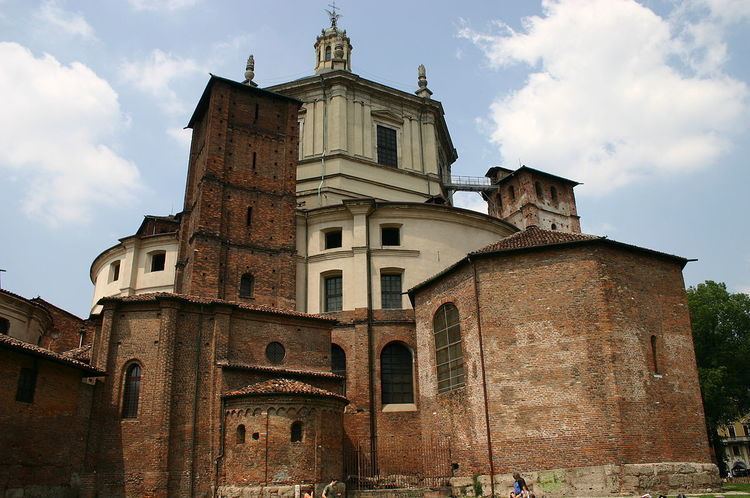 | ||
Early Christian churches in Milan are the first churches built immediately after the Edict of Milan (Edictum Mediolanense) in February 313, issued by Constantine the Great and Licinius, which expressly grants tolerance and religious liberty to all religions within the Roman Empire.
Contents
Historical and artistic context
Ever since the fall of the Severan dynasty, which ruled the Roman Empire between 193 and 235, rivals for the imperial throne had bid for support by either favoring or persecuting Christians. During the following period known as the crisis of the Third Century (AD 235–284) the Roman Empire nearly collapsed under the combined pressures of invasion, civil war, plague, and economic depression. The Crisis began with the assassination of Emperor Alexander Severus at the hands of his own troops, initiating a fifty-year period in which 20–25 claimants to the title of Emperor, mostly prominent Roman army generals, assumed imperial power over all or part of the Empire.
During the Civil wars of the Tetrarchy, starting in 306 AD with the usurpation of Maxentius and the defeat of Flavius Valerius Severus, and ending with the defeat of Licinius at the hands of Constantine I in 324 AD, Diocletian moved the capital of the Western Roman Empire from Rome to Mediolanum, the ancient Milan. Diocletian chose to reside at Nicomedia in the Eastern Empire, leaving his colleague Maximian at Mediolanum. Maximian built several gigantic monuments, the large circus (470 m × 85 m (1,542 ft × 279 ft)), the thermae or "Baths of Hercules", a large complex of imperial palaces, and other services and buildings of which fewer visible traces remain. Maximian increased the city area surrounded by a new, larger stone wall (about 4.5 km (2.8 mi) long) with many 24-sided towers.
An edict of toleration was issued by the emperor Galerius from Serdica and posted at Nicomedia on 30 April 311. By its provisions, the Christians, who had "followed such a caprice and had fallen into such a folly that they would not obey the institutes of antiquity", were granted an indulgence. Their confiscated property, however, was not restored until 313 when instructions were given for the Christians' meeting places and other properties were to be returned and compensation paid by the state to the current owners: The Christian communities of Mediolanum contributed its share of martyrs during the persecutions, but the first bishop of Milan who has a firm historical presence is Merocles, who was at the Council of Rome of 313.
It was from Mediolanum that the Emperor Constantine issued the Edict of Milan in 313 AD, granting tolerance to all religions within the Empire, thus paving the way for Christianity to become the dominant religion of the Empire. Constantine was in Mediolanum to celebrate the wedding of his sister to the Eastern Emperor, Licinius. The agreement between Constantine and Licinius directed the provincial magistrates to execute its orders at once and with all energy, so that public order may be restored and the continuance of the Divine favor may "preserve and prosper our successes together with the good of the state.". It marked the beginning of profound and radical transformations; the encouragement of Christian worship led to the methodical destruction of Christian monuments invisible to the authorities. In this regard it is interesting to note that stones taken from the amphitheater have been recognized on the basis of the Basilica of San Lorenzo (English: Basilica of St. Lawrence; 45°27′30″N 09°10′55″E), signing the demolition of the large building (129.5 m × 109.3 m (425 ft × 359 ft)) This use was justified because of the presence of waterways around the area where San Lorenzo was built, and because there was a scarce presence of large stones in Milan, being in a plain clay. Whether this fact, the positioning of the famous columns before the courtyard indicates that the building of the great cathedrals of the imperial era was also done at the expense of Roman buildings.
The early Christian basilicas in Milan can be divided into several categories, corresponding to their periods.
The first basilicas we know are divided into two separate churches, one for the baptized, being the sacrament of baptism at that time granted only upon completion of a process of conversion and spiritual purification, and the other for catechumens. This particular conformation perhaps derived from horrea, a type of public warehouse used during the ancient Roman period, such as the ancient buildings of Aquileia. The Basilica di Santa Tecla (45°27′50″N 45°27′50″E), whose ruins can be visited under the Milan Cathedral, has apse of traditional type, reminiscent of those of the churches annexed to great civic buildings.
A later stage corresponds to that of the great cathedrals of the late Roman Empire. They are formed by a polygonal shape and cross-stitch. These churches were the models adopted for some of the largest most famous basilicas of the late Roman Empire, such as those in Constantinople.
The first churches in Milan
The religious center of the city, now Piazza del Duomo, included two cathedrals: the basilica vetus or basilica minor, used during the winter season, and basilica nova or basilica major, used during the summer. These churches are only partly known because the Milan Cathedral has been built over there.
Ambrosian basilicas
Aurelius Ambrosius, better known in English as Saint Ambrose, archbishop of Milan and one of the most influential ecclesiastical figures of the 4th century, dominated the life and development of the city. He was appointed Bishop of Milan on 7 December 374. With him began a program to build basilicas dedicated to various categories: a basilica for the prophets, one for the apostles (San Nazaro in Brolo), one for the martyrs (martyrium, which later housed his remains and became the Basilica of Sant'Ambrogio), one for the virgins (Basilica of San Simpliciano). One of the four original doctors of the Church, he is patron saint of Milan.
Other churches
Other early Christian churches in Milan that preserve some of their Palaeo-Christian appearance are:
